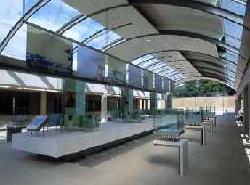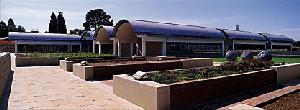|
Frozen In Time Hundreds of millions of seeds from the world's most endangered species are to be housed in an underground vault, deep in the English countryside. The Millennium Seed Bank Project will safeguard 24,000 plant species worldwide against extinction and all of the UK's native wild plants. The £9.2 million (US$12.9 million) vault at Wakehurst Place in Sussex was officially unveiled to the public last week by Prince Charles. When the seed bank reaches its goal of collecting and conserving 10 per cent of the world's seed bearing plants by 2010, the vault will house a broader biodiversity than anywhere else on the planet. The £80 million (US$112 million) international conservation project is the biggest of its kind, and the first to attempt plant conservation on a scale matching the current threat of plant extinction. Plants are the basis of life on Earth, trapping the energy of the sun to generate oxygen and providing nourishment and other essential living requirements to almost all forms of life, including thousands of mammals, birds and millions of insects. The world's tremendous diversity largely depends on the diversity of plant species. If the plants are lost, a huge proportion of the world's other living organisms will disappear, too. The Royal Botanic Gardens in Kew, manages Wakehurst Place, near Haywards Heath, 80 kilometers south of London. Director, Professor Peter Crane, said the project is a serious measure. "It is appropriate to the desperate situation we face," said Crane. "Around the globe and especially in the tropical drylands, habitat destruction and environmental degradation are taking place at an alarming rate. "Wild plants today are under greater threat of extinction that at any time since the last Ice Age." Said Prince Charles at the opening. Kew's "seed hunters" are busy around the world, particularly in dryland areas, working with international partners to identify and collect seeds to bring them back for safekeeping far into the future. Burkina Faso, Kenya, Madagascar, Lebanon, South Africa, and the United States have signed agreements forging vital links to enable conservation initiatives to take place. This morning, Western Australia said it, too, will participate, by collecting seeds of 1,400 of the state's rarest species for shipment to the UK. "Western Australia is well placed to play an active role in such an important project," said Western Australia Environment Minister Cheryl Edwardes. "The loss of biodiversity is of enormous concern, particularly in Western Australia, where as many as 450 native plant species are at risk because of encroaching salinity in the species rich Wheatbelt region. "In the event a species is lost, then we at least will have a reserve of seed that can be used to re-establish populations in suitable habitat." Conservationists from collaborating countries have been invited to Wakehurst Place to share technology and know how. After shipment to Wakehurst Place, the seeds are carefully sorted, cleaned and dried before being frozen to -20 Celsius so that they should last for hundreds of years. Though unexciting to look at, Kew staff describe the seeds as "tiny miracles of packaging, containing all the genetic information for the next generation of plants." The Millennium Seed Bank builds on the knowledge and expertise that the Royal Botanic Gardens, Kew has developed in seed conservation over the last 25 years at Wakehurst Place. Researchers recently germinated one of the very first seeds it placed into its experimental seed bank back in 1974. After 25 years the Cock's-foot (Dactylis) sprouted at the first attempt - little green shoots on a petri dish of agar gel. The conditions inside the seed bank slow down the rate at which plants deteriorate and at which they lose their ability to germinate. Seeds of some plants such as maize (Zea mays) and barley (Hordeum vulgare) can probably last thousands of years in a cold store or a seed bank. For some wild plants, centuries is probably a more realistic figure, said Kew researchers. This is far longer than most would survive in the wild. It is expected that 80 percent of the species stored at Wakehurst Place will live for at least 200 years. Last week, Prince Charles opened the Millennium Seed Bank Exhibition, which allows the public an inside view into the project and the processes involved in biodiversity conservation and seed banking. In the entrance room, visitors see a huge glass wall filled with seeds, showing spectacular diversity. An introductory video explains the vision behind the project. In the main exhibition space, big windows connect the display with the seed processing and research laboratories of the Royal Botanic Gardens, Kew's Seed Conservation Department. Here, the public can watch seed processing and research in practice. To find out more about the project, visit www.rbgkew.org.uk/seedbank /msb.html. .
|



